#... renin
Explore tagged Tumblr posts
Text
I'm not saying I ship it (Renee/Allison is superior and I'll die on that hill), but how come I never see Renee and Kevin getting paired? HEAR ME OUT they could actually be good for each other:
They both came from really abusive and lonely childhoods (unsurprising, they're foxes). But then they both connected with a parent that basically saved their lives.
Kevin is called a dreamer for what he sees in people. Renee has enough faith and hope to make up for the rest of the foxes.
They both care about Andrew AND they both had a little something something with Jean, even if it was allegedly one-sided (Kevin 👀)
Kevin saw Andrew's potential and worked to help him see it as well. Now, he's helping Jean to believe in his own worth away from the nest.
Meanwhile, Renee saw past the monster in Andrew, and she saw past the defeat in Jean
Kevin was the first to notice Neil's crush on Andrew. Renee was the first to notice Andew's crush on Neil. Matchmaking duo amiright??
Renee is good at Exy. I think she gets compared to Andrew, a literal prodigy, way too often. She's good at it, and Kevin definitely sees that.
On the exy note, I actually think that Renee could actually enrich Kevin's perspective on exy. He has such a pure relationship with it already; he cares about having fun and playing fair. Renee not only (probably) shares that sentiment, but she cares about the good it can do. She uses a platform that's known for its violence (and its potential ties to a cult and/or mafia) to run charities.
By the end of the series, Kevin has developed. He's not nearly as dramatic or dependent on others anymore, and I think he's in a position to start forming some healthy relationships. Renee should be with someone who's already done a lot of the growing on their own, and so should Kevin.
That being said, I'm sure that Kevin is always going to worry about being safe to some degree or other. And we all know that Renee is perfectly capable of gutting a man.
IN CONCLUSION would they be super cool or edgy? No, and that's so interesting to me. I think they'd end up being such a kind, even quiet, force of love and hope together.
#i literally think there are two fics on ao3 about them#I need more#I honestly think that Kevin would benefit with someone a little less tunnel visioned with exy#renee walker#kevin day#renin?#kevee?#jean moreau#andrew minyard#aftg#all for the game#tfc#trk#tkm#tsc#odd pairing for sure though#renison
60 notes
·
View notes
Text
Hey guys, so I’ve been coming up with a little original story that I wish to get animated!
—-
An Alien Invasion happens on our modern world. Determined to save their planet, the humans fight back, starting a war that would last decades. Despite all this, both sides lose, due to the explosion of an atomic bomb…
Several years later
A fallen soldier, Renin Amil, finds himself alive in the body of a robot. His brother, Piers Amil, was a scientist -who through a series of experiments brought Renin back to life. Renin finds Pier's scientific journal labeled, Satellite Trials, to find one last entry. A plead for Renin to find someone to continue his work and bring humanity back.

SATELLITE TRIALS
Anyways here’s our main cast!
(All details are subject to change) (and the character explanations will be in separate posts!)
OUR HUMAN TURNED ROBOT PROTAGONIST….
RENIN AMIL

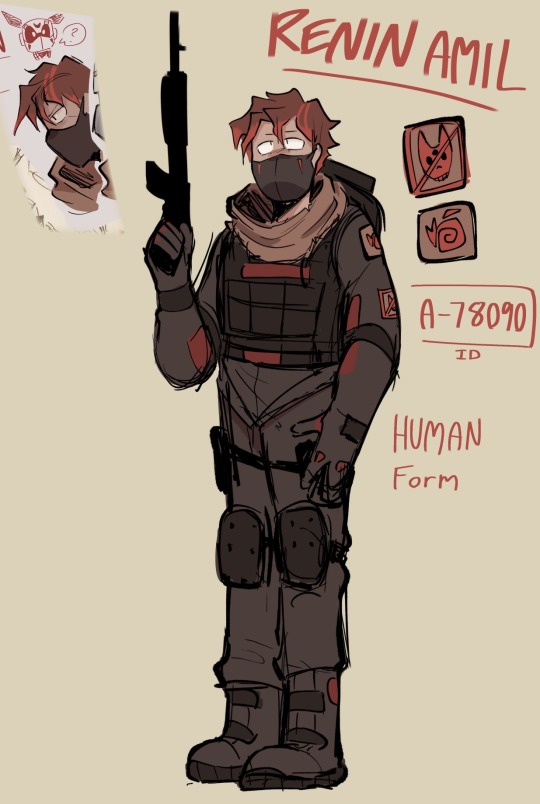
OUR LOVING AND CRAFTY LITTLE MECHANIC,
ORION EPOCH


AND FINALLY OUR CONFIDENT RESOURCEFUL TRICKSTER,
ALI

I will make posts for each respective character later on! Now here’s a bunch of silly doodles I have.

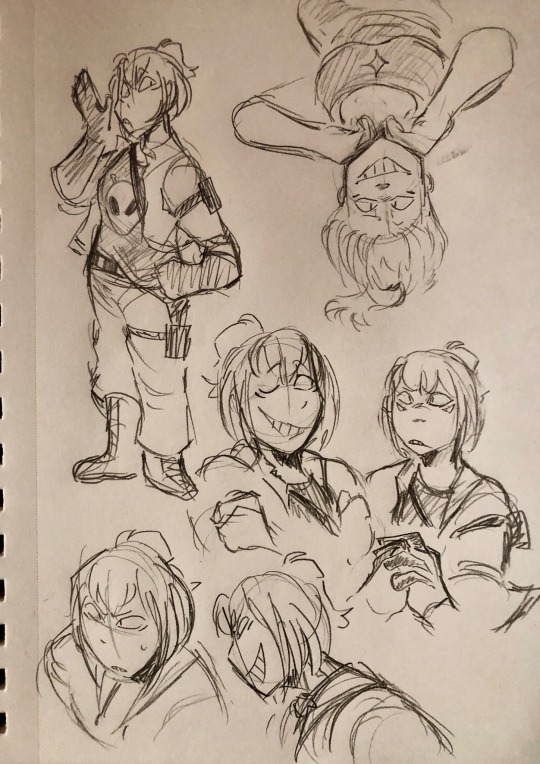








Anyway, I hope you enjoy my silly idea! My wish is to perhaps make this at least into an animated Pilot...which would probably be very hard, but I gyatt this prolly!!
This started out as a short story for a class assignment, but I got too attached to my characters and story... I already got so much lore for this. So hey, if you want
to see more of this be sure to stick around!! :]
#scifi#post apocalyptic#aliens#robots#ocs#original story#alien apocalypse#Renin Amil#Orion Epoch#Ali#Satellite Trials#veearrifararriboom#digital art#traditional art#art#ST#children go to war#They are all truamatized <33
8 notes
·
View notes
Text
Unfortunately doctors keep proving me right in my delusion that i am a better doctor than all doctors. It’s not their fault tho i have more information than they do (intimate knowledge of any “patient” i’m going to venture an opinion on, incl self)
9 notes
·
View notes
Text
^^ he is thinking about My Boy our buddy renin
thinking about Blorbo From Ari's Mind
4 notes
·
View notes
Note
Is your url an ACE inhibitor pun? That’s my headcanon when you pop up on my dash
noooo haha it was originally intended to be “stuck in april” (a username w sentimental meaning to me) but a lot of ppl have sent me asks saying they thought it was “stuck in a pril”/an ACE inhibitor pun (for those of u who don’t know, most ACE inhibitors have the suffix -pril). I’m lowly starting to love it as a pre-med biochemistry major SO…. at this point I’m willing to run w either interpretation
#I say stuck in april basically but it’s up to interpretation 😍 and I’m good w either one#the timing of this ask is incredible btw bc I was JUST reviewing my flash cards on the renin angiotensin aldosterone system#I love that this username is an unintentional scientific pun… I think I rly won w this one#ask
19 notes
·
View notes
Text
i got a 94 on my (cumulative!) physiology final which does make me feel a bit better abt posting fandom shipping etc shit as an adult
#youre not allowed to post sheriffgiggle unless you understand the renin angiotensin mechanism ☝️ this is known#jude talks
3 notes
·
View notes
Link
See also:
https://pubmed.ncbi.nlm.nih.gov/36762752/
SIBO ("Small Intestinal Bacterial Overgrowth") is a novel pathology of COVID-19 [1-4]. SIBO is thought to be related to the dysfunction of the renin-angiotensin system (RAS) [5], which can be induced by infection with the SARS-CoV-2 virus or by the vaccine Spike protein (Spike protein from the COVID-19 vaccines) [6-8]. The RAS is a ubiquitous physiological and hormonal system in the human body, involved in renal, pulmonary, and cardiovascular autonomic functions, and its dysfunction is responsible for COVID-19 diseases [7].
Interestingly, RAS also controls renal, pulmonary, and cardiovascular autonomic functions, as well as innate immunity and various microbiota, including the intestinal microbiota. The intestinal microbiota is made up of about 10,000 billion microorganisms (bacteria, fungi, and yeasts) living as specific communities and establishing a powerful symbiosis with our body. About 160 bacterial species have been identified. This microbiota plays a crucial role in digestion, cellular metabolism, and immunity (the intestinal microbiota actively participates in the proper functioning of our immune system). In our opinion, SIBO, the etiology of which is still a mystery, is an intestinal dysbiosis mediated by the dysfunction of the RAS. Dysbiosis is an imbalance of the intestinal microbiota, resulting from a decrease in the number of "good" bacteria or an increase in "bad" bacteria or both
Under normal conditions, the colon of an individual harbors low numbers of aerobic Gram-positive bacteria, while the small intestine contains high numbers of anaerobic Gram-negative bacteria. The aerobic bacteria in the small intestine are beneficial because they participate in the digestion of food and the absorption of nutrients (they also allow the production of vitamins K, B8, B9, and B12, as well as short-chain fatty acids, while regulating the absorption of calcium, magnesium, and fatty acids). These bacteria promote the mobility of ingested food in the intestinal tract. The bacterial balance in the small intestine is maintained by the Ileocecal valve (which prevents retrograde translocation of bacteria from the colon to the small intestine), gastric acids (killing microorganisms, including pathogenic bacteria) produced by gastric cells, and the presence of immunoglobulin A in the intestinal tract [10, 11]
SIBO results from the migration of bacteria from the colon to the small intestine, where they excessively multiply (a pullulation of bacteria from the colon into the small intestine). While the function of the small intestine is the absorption of food, the function of the colon is the subsequent fermentation of the non-digestible food residues or wastes produced.
Thus, during SIBO, an early and abnormal fermentation of food is initiated directly in the small intestine by the anaerobic bacteria of the colon, causing more or less severe digestive disorders associated with various potentially highly disabling pathologies
In neurological disorders, intestinal dysbiosis is observed among patients suffering from depression or anxiety, Alzheimer's or Parkinson's disease, schizophrenia, and other autistic or bipolar disorders. All of these pathologies are associated with RAS dysfunction (and overactivation of the AT1R receptor)
In the end, cooperation between specialists from different scientific or medical disciplines is desirable for the benefit of patients. Subsequently, there is no doubt that SARS-CoV-2, COVID-19, and RAS are at the interface of various disciplines, such as virology, immunology, pharmacology, endocrinology, and physiology.
0 notes
Text
It's already cruel how Min has been given questions with a limit of 5 seconds each, which is undoubtedly not enough time to answer any question properly, but paying close attention to the questions themselves that Min failed to answer correctly, truly doubles the cruelty of her execution. The first one, "Devise a solution to the Riemann Hypothesis" — which she had lost her dominant arm to — is the biggest unsolved problem in mathematics to date. To fail this question is not her failing as a student; she hadn't a chance in the first place. Then, as her dominant arm is bleeding, in mockery she ironically receives a question about the renin-angiotensin system, which is activated by blood loss.
Awful as is, but it's specifically the question after that which sticks out to me in particular: "List 10 reasons for why you don't deserve to die", is by all means a loaded and accusatory question to ask someone who's being executed, and Min's self-deprecating answer of "I do" as she's crying doesn't exactly come as a surprise. Rather, what does seem noteworthy to me, is that the killing game interprets her answer as incorrect.
The very killing game that is designed to go on until everyone is dead, and who's rulebook states that all murderers must be held accountable for their crimes — the very one, insists that Min doesn't deserve to die. She still has to, of course, but this means the killing game does recognize that she's a victim in all this, or if not that — at least, that her actions don't warrant a death sentence. This might seem like an obvious conclusion, but considering how much the series has an emphasis on how they're all supposed to die there -- that not everyone deserves to, just has to, seems like an important detail to me.
Furthermore, it feels just all the more cruel towards Min. Min, who's whole character is about her lack of agency in any event in her life, how she's always just the product of her circumstances, unable to influence its outcome. If the answer rung true, stating that she deserves to die, it'd insinuate that she had a part in her fate, even if it's a horrible one. But no, even that is denied from her. Not even her death had she any say on. Teruko's words prior her execution had stated the same, telling her that it was merely Teruko's Luck that made Min save her, not her own volition — but now, even the killing game itself agrees with that statement. There was never a choice involved.
91 notes
·
View notes
Text
From my story Satellite Trials which is explained more here

Renin Amil is a strong, rule-abiding ex soldier. As a child he always dreamed of being a “hero” fighting in the Alien vs. Human war. Safe to say, it wasn’t all he thought it was. At 16 he was thrown on the battle grounds and lost many of his friends. A year later he lost his own life.
Several years after the nuclear explosions, Renin wakes up to a world he never knew. As well as a note from his brother, one last task, to save humanity.
So anyways he’s like really serious, freezes in fight or flight, finds it hard to decide things for himself, but as he does learn to relax and have more fun he becomes much more confident.









#satellite trials#ST#Renin Amil#oc art#ocs#original story#original character#digital art#traditional art#art#sci fi#robot#robots#aliens#post apocalyptic#apocalypse
4 notes
·
View notes
Text
Different effects of quercetin on immune cells involved in asthma.
The more we learn about Natural therapeutics for treating Spike Protein injury/disease, the more we realize that, in addition to Vitamin D, Quercetin may be one of the most essential supplements. In addition to the previously discussed benefits of Quercetin, there is yet another, which is equally important. This is the ability of Quercetin to stabilize Mast Cells and inhibit their activation.
Why is this important? Because the Spike Protein, regardless of source, can activate Mast Cells.
The viral or vaccine Spike protein can induce various major impairments and dysfunctions within the human body [8-20], among which is MCAS. Thus, the latter can be triggered by natural infection with SARS-CoV-2 or be directly induced by vaccination or booster shots against COVID-19. This occurs through dysfunction of the renin-angiotensin system (RAS) and overactivation of AT1R and Toll-like (TLR) receptors, which drive innate immunity (and therefore adaptive or acquired immunity) [9-11]. In patients with this syndrome, mast cells exhibit hyperactivation, releasing chemical mediators excessively and inappropriately.
SARS-CoV-2 or Vaccinal Spike Protein can Induce Mast Cell Activation Syndrome (MCAS) https://pubmed.ncbi.nlm.nih.gov/38693735/
For readers who may not know what MCAS is, here is a brief overview.
8 notes
·
View notes
Text
Also preserved in our archive (Daily updates!)
As part of the COVID-19 International Research Team, researchers at the Johns Hopkins Kimmel Cancer Center, Children's Hospital of Philadelphia, the University of Pittsburgh and Weill Cornell Medicine discovered a novel cause of cytokine storm -; the extreme inflammatory response associated with increased risk of death in COVID-19 infection.
Their findings were reported Nov. 27 in the online issue of Proceedings of the National Academy of Sciences.
In an intensive genomic search for causes of cytokine storm, the research team used autopsy samples obtained from 40 patients who died from COVID-19. They performed genome analysis on samples taken from multiple sites, including the lung, heart, liver, kidney, lymph nodes in the chest that initially filter the virus, and the nasal cavity where the virus enters the body.
They zeroed in on some 50 upregulated immune genes in the samples obtained from nasal swabs and followed through in the genomics for the autopsy tissues.
Stephen Baylin, M.D., Virginia and D.K. Ludwig Professor for Cancer Research and co-senior author, and first author Michael Topper, Ph.D., Evelyn Grollman Glick Scholar and instructor in oncology, were
familiar with many of the genes as part of the inflammasome, a protein signaling network they helped define that is activated to rid the body of virus or bacteria-infected cells.
"Some of the same genes involved in overactivation of the inflammasome appear to be key immune gene regulators of the hyperinflammatory process that leads to a new view of how these subsequently activate the "cytokine storm syndrome" and severely damage multiple tissues, says Topper.
The genes should turn on and off, Baylin explains, but when they stay on, it results in cytokine storm, the very severe inflammation that can be lethal to patients with COVID.
Essentially, immune genes in the nasal cavity, where the virus enters, send signals downstream through a system called renin-angiotensin-aldosterone system (RAAS) to initiate cytokine storm.
RAAS, a hormone system that normally turns on and off to help regulate blood pressure, body fluids and electrolytes, is the spark that pushes the immune response into overdrive, the researchers found, compromising the infection-fighting function of lymph nodes and causing severe damage to the lungs, kidneys, heart, liver and other organs.
The researchers also believe their findings may have implications for long COVID, a chronic condition following COVID-19 infection that is characterized by a wide range of symptoms, including fever, fatigue, coughing, chest pain, heart palpitations, headaches, joint and muscle pain, gastrointestinal issues and more. This is a focus of ongoing research, Topper and Baylin say.
In addition to Baylin and Topper, other researchers participating in the investigation are co-first author Joseph W. Guarnieri and co-corresponding authors with Baylin: Afshin Behesti (leader of COVIRT) and Douglas C. Wallace, Simon Pollett, Deanne Taylor, Eve Syrkin Wurtele, Robert E. Schwartz, Christopher E. Mason, Jeffrey A. Haltom, Amy Chadburn, Henry Cope, Justin Frere, Julia An, Alain Borczuk, Saloni Sinha, JangKeun Kim, Jiwoon Park, Daniel Butler, Cem Meydan, Jonathan Foox, Yaron Bram, Stephanie A. Richard, Nusrat J. Epsi, Brian Agan, Josh G. Chenoweth, Mark P. Simons, David Tribble, Timothy Burgess, Clifton Dalgard, Mark T. Heise, Nathaniel J. Moorman, Victoria K. Baxter, Emily A. Madden, Sharon A. Taft-Benz, Elizabeth J. Anderson, Wes A. Sanders, Rebekah J. Dickmander, Katherine Beigel, Gabrielle A. Widjaja, Kevin A. Janssen, Timothy Lie, Deborah G. Murdock, Alessia Angelin, Yentli E. Soto Albrecht, Arnold Z. Olali, Zimu Cen, Joseph Dybas, Waldemar Priebe, Mark R. Emmett, Sonja M. Best, Maya Kelsey Johnson, Nidia S. Trovao, Kevin B. Clark, Victoria Zaksas, Robert Meller, Peter Grabham, Jonathan C. Schisler, and Pedro M. Moraes-Vieira.
This researach was supported by the Division of Intramural Research, NIAID, NIH grant to Sonja Best, and DOD W81XWH-21-1-0128 grant awarded to Douglas Wallace, the Bill & Melinda Gates Foundation Grant INV-046722 awarded to Douglas Wallace, Adelson Medical Research Foundation, Hodson Scholar Foundation, Glick scholar awards and Samuel Waxman Research Foundation awarded to Stephen Baylin from the Defense Health Program (HU00012020067 and HU00012120103), the National Institute of Allergy and Infectious Disease (HU00011920111), and the USU RESPONSE award (HU00012020070).
Source: Johns Hopkins Medicine
Journal reference: Topper, M. J., et al. (2024). Lethal COVID-19 associates with RAAS-induced inflammation for multiple organ damage including mediastinal lymph nodes. Proceedings of the National Academy of Sciences. doi.org/10.1073/pnas.2401968121.
Study link: www.pnas.org/doi/10.1073/pnas.2401968121
#mask up#public health#wear a mask#pandemic#wear a respirator#covid#covid 19#still coviding#coronavirus#sars cov 2#long covid#covid is not over
11 notes
·
View notes
Text
Artfight Batch 3: Attacks #13-18
(Previous)


Aurelia ( @pokezyp )
Beetle ( @starsmidnighttrial )


Pumpkit ( @soweli-musi )
Renin ( @aviondraws )


Magpie ( @cockatricegutz )
Lavey ( purpieishere )
(Next)
15 notes
·
View notes
Text
oon niin ylireagoija oikeesti tää on naurettavin asia taas hetkeen ihan niiku Mä Voisin Vihaa Sitä
ikävä sitä taas.... pitäs mennä pyykkää.... ehk siit on mulle jotain hyötyy jos meen renin kaa istuu pyykkitupaan tunniks
2 notes
·
View notes
Note
Sundial Fates sounds so interesting! What's your favorite thing about it? (Please feel free to go off, I love when writers ramble about their stories!)
Aaaaaah thanks for the ask!
Man, I don't even know where to start lmao, this series has been rotting in my brain for 15 years. I guess it would start with my absolute disaster of a cast. We've got Tristán, chronic daydreamer who's in way over his head, Christina, who doesn't start fights but will end them, and Wade, who thinks he's tough but after 10 books still has no idea how he ended up in this mess. Then there's Cato who suffered so much cultural whiplash going from first century AD to 25th century to 19th century that nothing fazes him anymore (not to mention the alien voice in his head). Claudius (or maybe Claude idk anymore) who just wanted to invent a time machine and save his brother who ended up breaking reality at some point (??? plot points are changing but he basically started this whole mess). Ssrenthir, Lord of Mora who watched his entire planet explode and is now willing to commit genocide to protect his people. Renin, who blames Ssrenthir for his moon getting caught in said explosion. The Other Wade, who also doesn't know how he ended up in this mess but is very angry about it. And then there's Lasky, who does whatever the hell he wants. None of them want to be here, but since they are, they're going to make it everyone else's problem.
This is my barely marketable, pulp sci-fi fun project inspired by watching too much Sliders and Brisco Country Jr. These characters will get into old fashioned wild west shootouts. They will also go to the moon. They will meet dinosaur people. Some of them will get better. Some of them will get worse. Put any two of them in a room together and it's a toss up whether they'll team up to escape the room or start a fight. I love them all and really look forward to diving back into this story (even though it's not my main focus atm, they're always rotating in my head).
So, uh, yeah, I guess that's my favorite bit, haha. Thanks again for the ask XD
3 notes
·
View notes
Text
The pathophysiology of hypertension
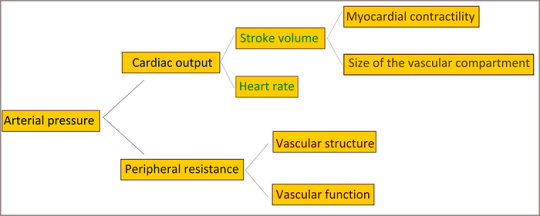
Introduction
Hypertension, or high blood pressure, is a complex medical condition affecting a significant proportion of the global population. Despite its prevalence, there remains uncertainty regarding its pathophysiology, with essential hypertension constituting a substantial portion where no single identifiable cause is found. This comprehensive discussion aims to delve into the physiological mechanisms involved in the development of hypertension, exploring factors such as cardiac output, peripheral resistance, the renin-angiotensin-aldosterone system, the autonomic nervous system, endothelial dysfunction, genetic factors, and intrauterine influences.
Cardiac Output and Peripheral Resistance
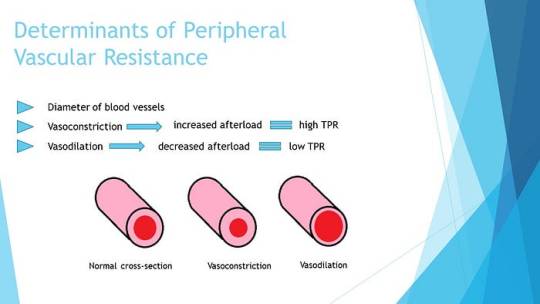
Maintaining normal blood pressure relies on the delicate balance between cardiac output and peripheral vascular resistance. Essential hypertension often involves a normal cardiac output but elevated peripheral resistance, primarily determined by small arterioles. The role of smooth muscle cells, calcium concentration, and structural changes in arteriolar vessel walls contribute to the irreversible rise in peripheral resistance.
Renin-Angiotensin System
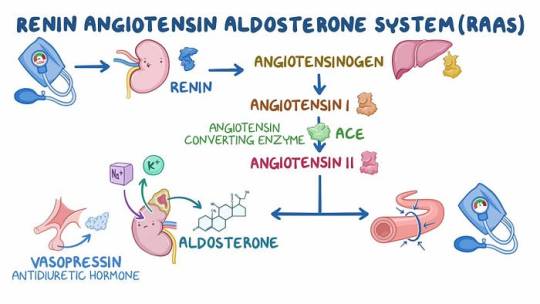
The renin-angiotensin system plays a crucial role in blood pressure regulation. Renin, released in response to various stimuli, initiates the conversion of angiotensinogen to angiotensin I, which is then converted to the vasoconstrictor angiotensin II. This system also stimulates aldosterone release, promoting sodium and water retention. While the circulating system may not be directly responsible for essential hypertension, local renin-angiotensin systems in organs like the kidney, heart, and arterial tree gain significance in regulating regional blood flow.
Autonomic Nervous System

Sympathetic nervous system stimulation affects arteriolar constriction and dilation, playing a pivotal role in maintaining normal blood pressure. Although the exact role of epinephrine and norepinephrine in hypertension etiology remains unclear, drugs blocking the sympathetic nervous system demonstrate therapeutic efficacy.
Endothelial Dysfunction
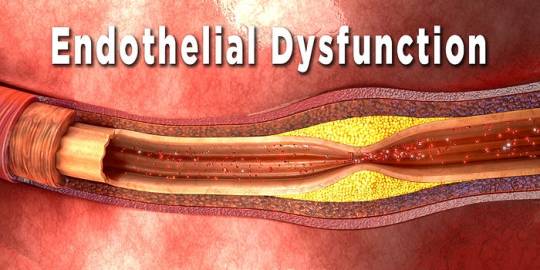
Vascular endothelial cells, producing vasoactive agents like nitric oxide and endothelin, play a key role in cardiovascular regulation. Endothelial dysfunction, implicated in essential hypertension, involves impaired production of nitric oxide. This dysfunction, once established, becomes irreversible, highlighting its primary nature in hypertension.
Vasoactive Substances

Various vasoactive substances, such as bradykinin, endothelin, atrial natriuretic peptide, and ouabain, influence sodium transport and vascular tone. These substances contribute to the delicate balance in maintaining normal blood pressure.
Genetic Factors
Genetic predisposition significantly contributes to hypertension, with specific mutations linked to disorders like Liddle’s syndrome, glucocorticoid-remediable aldosteronism, and others. The intricate interplay of multiple genes makes it challenging to pinpoint individual contributions.
Intrauterine Influences
Fetal influences, particularly birth weight, emerge as determinants of adult blood pressure. The Barker hypothesis suggests a link between low birth weight, metabolic abnormalities, and hypertension in later life. However, the role of genetic factors in this relationship requires further exploration.
Diastolic Dysfunction
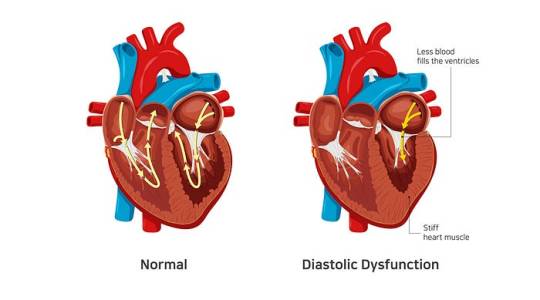
Hypertensive left ventricular hypertrophy leads to impaired diastolic relaxation, affecting ventricular input during exercise. This dysfunction contributes to increased atrial pressure, pulmonary congestion, atrial fibrillation, and potential complications like pulmonary edema.
Conclusion
In conclusion, understanding the pathophysiology of hypertension involves a multifaceted exploration of various physiological mechanisms. While essential hypertension remains a complex and often multifactorial condition, advancements in research shed light on factors such as cardiac output, peripheral resistance, the renin-angiotensin system, the autonomic nervous system, endothelial dysfunction, genetic influences, and intrauterine factors. A comprehensive understanding of these elements is crucial for developing effective therapeutic strategies and preventive measures against the global burden of hypertension.
We hope this helps in improving our comprehension of the Hypertension condition. All the best in your journey in the medical field.
Incase of any challenges' and in need of professional guidance, contact;
Expert Academic Assignment Help at;
#fullmetal alchemist#healthcare#medical students#assignment help#aesthetic#puppies#kittens#ratblr#fourteenth doctor#tenth doctor#doctor who#14th doctor#medicine#medicare#medication#nursing school#nursing student#nurses#nurse#pharmercy#pets#health tips#health and wellness#online pharmacy#pharmacy student#pharmacy technician#pharmacy colleges#phar
5 notes
·
View notes